20% off all products! Sale ends tonight at midnight EST.

- Art Subjects
- Curated Collections

Sailboat Paintings
Featuring all kinds of sailboats, from sloops to schooners and yachts to yawls, this collection of paintings has something for everyone. these pieces of art invoke deep emotion with pictures of stormy weather, sleepy harbors and majestic, three-masted ships. with so many different styles and motifs to choose from, sailing enthusiasts can find the perfect piece for their collection. ... more.
1 - 72 of 777 sailboat paintings for sale grouped by artist

Results: 777
Sunset Calm in the Bay of Fundy

William Bradford

New Yorker Cover - June 13th, 1959

Arthur Getz

Perfectly Peaceful Nantucket

Joyce Hicks

Summer Regatta

Julia Purinton

Sailing a Dory

Winslow Homer

Path in the Wheat at Pourville

Claude Monet

Bermuda Cove #2

Sea Breeze Trail

Chuck Pinson

Girl At The Ocean

Irina Sztukowski
476 Designs

Lighthouse Sail

Karla Gerard

A passing squall

Gary Giacomelli

Sailing on the Sound

Steve Henderson

Yellow Sailboat and Coronado Boathouse

Mary Helmreich

Set Free- Sailboat Painting

Linda Woods

Subtle Mist 1

Carol Robinson

Broad Reach

White Sabot

Amy Kirkpatrick

Full Sail I #1

Jane Slivka

Sailing Away

Lucie Bilodeau

Bathers at Bellport #4

William James Glackens

Sailing At Sunset I

Patricia Pinto

Coastal Lullaby

Hailey E Herrera

Sailing Ship Fighting Waves And Storm In The Sea, Ships Vintage Collection, No 01

MOUNIR KHALFOUF

Inlet with Sailboat, Maine 1913

Maurice Prendergast

Mindy Sommers

Sailboats I

South Social D

Regatta On The Sea

Dan Meneely

Autumn Harbor

David Rogers

Vibrant sailboats

Moored Boats on San Diego Harbor

Paul Strahm

Sunset Sailboat diptitch

Laurie Snow Hein

North Carolina Sailboats

Dorrie Rifkin

sail boat a Manarola

Guido Borelli

Menominee Marina

Sailing Takes Me Away

Tina LeCour

Afternoon by the Sea, Gravesend Bay 1888

William Merritt Chase

Sailing Day

My Head Cinema

Abstract Golden Sailboat Painting with Water Reflections

Clark Leffler

Maryland Blue Crab

Debbie DeWitt

A view from the pier

Mick Williams

Sailing on Puget Sound
Diane McClary

Beach Time Step 01

Janelle Penner

Jack Spurling

Ostsee Schoner - Baltic Schooner by Lyonel Feininger

Lyonel Feininger

Driftwood Coast II

Sue Schlabach

Ocean Symphony in Turquoise and Orange

Lourry Legarde

Ocean Sail V2 Light

Albena Hristova

Sailboats Vii

Chris Paschke

Sailboats At Sunrise Crop

Seaside Village II

Laura Marshall

Coastal Baby Pattern Xxx

Sailboats II

David Carter Brown

Majestic Sailboat

James Wiens

Coastal Buoys IIi V2

Anne Tavoletti

Sailboat Simplicity II

Silvia Vassileva

Bon Voyage Boat

Michael Mullan

At The Regatta I Sail Sq #1

Courtney Prahl

In The Moment Vii

Mary Jean Weber

Jeanette Vertentes

Sunday On The Coast Iv #1

Ship In A Bottle Ahoy Shiplap

Sara Zieve Miller

Lighthouse Sail Crop

Melissa Averinos

Cabanas I Pastel

Phyllis Adams

Natural Seashore I #1

Daphne Brissonnet

Sunday Morning Sail

Carol Rowan

Sandy Point #1

Avery Tillmon

Hong Kong Vintage Travel Poster

Vintage Travel Poster
Featuring all kinds of sailboats, from sloops to schooners and yachts to yawls, this collection of paintings has something for everyone. These pieces of art invoke deep emotion with pictures of stormy weather, sleepy harbors and majestic, three-masted ships. With so many different styles and motifs to choose from, sailing enthusiasts can find the perfect piece for their collection.
Products: | NumProducts: | Page List: | Tags: | Available Products: | Available Mediums: | Available Shapes: | Canonical Tags: | Date / Time Expiration: 12/25/2024 11:59:59 PM

10 Most Famous Ship Paintings
One of the most iconic painting niches in the world is that of ship paintings. For centuries, the world’s seas were dominated by various nations who sent trading vessels and warships out into the blue horizon.
Over many years, these ships became the lifeblood of the economies of certain countries like Portugal and Great Britain, their crews bringing and delivering precious cargo of all kinds.
Ships of all shapes and sizes have sailed the seas for more than a thousand years. The juxtaposition of a sophisticated man-made ship with the unpredictable and dangerous nature of the ocean and Mother Nature itself is part of what draws the admiration of so many art lovers and enthusiasts, especially along coastal regions.
Many artists throughout history have dabbled in producing works that featured ships and their legendary voyages on the high seas with some focusing solely on the subject of maritime travel. Here are some of the most famous ship paintings ever created.
Famous Ship Paintings
1. the fighting temeraire tugged to her last berth to be broken up – j.m.w turner.

One of J.M.W. Turner’s most famous paintings involves a well-known warship that was the star of at least one iconic battle for the British Royal Navy in the 18th century. His work is titled The Fighting Temeraire Tugged to her last Berth to be Broken Up, a lackluster, but fitting description of the fate of this once feared vessel that was pivotal to the nation’s fleet of warships.
The painting was done in 1839 and depicts the final moments of the Temeraire as it is slowly tugged out to sea to be dashed and parted out.
The painting is from the Romanticism era and is an interesting contrast between the changing technologies that were happening in maritime shipbuilding and travel during the early 1800’s.
The majestic and once-famous warship, who played a major role at the Battle of Trafalgar, is now being dragged away from port by a lowly, steam-powered tugboat.
It is a sad reminder that a certain sense of elegance and grandeur is often lost in what many deem to be a progressive advance of technology.
2. A First Rate Man-of-War Driven Onto a Reef of Rocks, Floundering in a Gale – George Philip Reinagle

The early 1800’s is likely the height of the era of famous ship paintings. One of the most well-known maritime painters was George Philip Reinagle, who was well-known for his ability to capture the essence of the sea’s sometimes tumultuous character that had destroyed so many powerful, strong vessels throughout history.
His 1836 work titled A First Rate Man-of-War Driven Onto a Reef of Rocks, Floundering in a Gale is aptly-named as it features just that—a ship that has been caught in the clutches of the raging sea.
One of the most intriguing aspects of maritime travel was the possibility that sailors could meet a terrifying demise if they were caught in a blustering storm, otherwise known as a gale.
This painting is iconic for Reinagle’s ability to depict the giant, crushing force of the waves along with the sea spray that has been kicked up by the high winds. This work is a grim reminder that not all seafaring travel and adventure ends safely.
Many ocean paintings containing ships will invariably make the ship the main focus, but in Reinagle’s piece it is the power of the ocean waves that dominate.
3. Battle of Trafalgar 1805 – Louis Phillipe Crepin

Some of the most famous ship paintings involve intense, deadly battles at sea between powerful naval fleets. Such is the case with Louis Phillipe Crepin’s 1805 work titled Battle of Trafalgar.
This painting depicts one of the most famous naval battles in history that took place in the year noted.
The Battle of Trafalgar featured the mighty British Royal Navy as they were pitted against two other worthy opponents—the Spanish and French naval forces—who had joined forces to try and topple the powerful force that had dominated the waters surrounding Europe and much of the world during this time.
Crepin’s painting portrays, with great accuracy, the close-quarters combat that so often occurred in naval battles.
4. Snow Storm – Steam-Boat off a Harbour’s Mouth – J.M.W Turner

As noted above, J.M.W. Turner was among the most famous artists who focused on the life and voyages of sailors and their ships.
Many times, these voyages were undertaken during powerful, unpredictable storms that all-too-often led to the ships capsizing and the entire crews being lost.
Turner’s 1842 work titled Snow Storm – Steam-Boat off a Harbour’s Mouth is one such painting that depicts the sea’s ability to make any vessel, large or small, feel the power of its might from time to time.
Also Read: Famous Lighthouse Paintings
The painting features the steam boat ship caught in a frigid snow storm , the wind sweeping and whipping in every direction as the ship struggles to stay on course and avoid succumbing to the massive waves.
According to many art historians, Turner went to great lengths to accompany various ships’ crews on their journeys so that he could paint his works as accurately as possible.
5. Becalmed off Halfway Rock – Fitz Hugh Lane

So many of the most famous ship paintings ever created feature vessels that are either engaged in raging battles, or caught in powerful gales on the open ocean. However, there are a few notable works that depict the calm, serene nature of the ocean or coastal areas.
Fitz Hugh Lane’s Becalmed off Halfway Rock is one such work that depicts a scene of beauty that few people outside the world of ships and sailing ever get to experience.
This 1860 work depicts ships anchored down next to Halfway Rock, a famous sea marker that is situated approximately halfway between Boston and Cape Ann.
This marker was a popular stop for trading vessels and supply ships as they could join up with other ships and carry out various types of maritime business at a specific location.
Lane’s work features a number of ships anchored down with small row boats working their way from one to another, likely swapping various cargo and other items.
6. Dutch Men-O’-War and Other Shipping in a Calm – Willem van de Velde II

Willem van de Velde II was a painter who specialized in maritime art during his career in the late 17th century.
This was a time when sailing ships were the height of mankind’s technological achievements and the naval fleets of various nations were the most vital part of any military force.
Velde’s work titled Dutch Men-O’-War and Other Shipping in a Calm was created in 1665 and features the Dutch navy’s vast fleet of ships that include the deadly and feared Men-O’-War vessels.
These ships were known as floating fortresses who possessed the ability to mercilessly pummel opposing ships or coastal forts and cities with impressive precision.
7. The Home Fleet Saluting the State Barge – Jan van de Cappelle

The mid-1600’s was a time in which maritime travel was responsible for reshaping the people and nations of the world as many pilgrims and travelers ventured to the New World across the Atlantic Ocean.
Jan van de Cappelle captured one instance of significance from this time period in his 1650 work titled The Home Fleet Saluting the State Barge.
The painting depicts a number of different ships gathered together in a port to salute a prominent vessel as it embarked on its voyage.
Cappelle’s work is one of the most well-known ship paintings in history as he masterfully depicts the water’s ability to mirror the happenings above its surface with stunning detail.
8. Argenteuil (Red Boats) – Claude Monet

Claude Monet is celebrated as one of the most famous impressionist painters , but most of his work featured scenes from dry land instead of ships and maritime travel. However, his 1875 painting titled Argenteuil (Red Boats) is among one of the most recognized ship paintings ever created.
This work features Monet’s trademarked Impressionist painting style and depicts a calm scene that features contrasting colors that truly highlight the boats in the center of the canvas.
The smooth water appears almost like glass in its ability to reflect the boats and their towering masts.
Monet’s brushstrokes vary greatly when one focuses on the sky above the water and the boats, which are crafted with short, choppy strokes that are able to convey great detail.
9. Nelson’s Inshore Blockading Squadron at Cadiz – Thomas Buttersworth

The British Royal Navy was at the peak of its seafaring prowess across much of Europe and the rest of the world during the latter half of the 18th century.
The nation’s powerful fleet engaged in many battles along the coast of Portugal during this time as the two countries were locked in a bout to control the waters around coastal Europe and other parts of the Atlantic.
Thomas Buttersworth painted a work in 1797 that is a testament to a great naval battle for the British forces off the coast of Lisbon. Following the famous Battle of St. Vincent, rear-admiral Nelson and 10 bargemen were engaging in a raid on Spanish gun-boats under the cover of darkness.
The Spanish commander realized his boats were under attack and launched an effort to defend them with 26 of his own men. Despite the British being heavily outnumbered, they managed to kill 18 Spanish sailors and capture the remaining few after a bloody sword fight ensued.
Buttersworth’s painting is a testament to that incident that was a historical victory for the British Navy.
10. Breezing Up (A Fair Wind) – Winslow Homer

One of the most iconic American paintings of all time was done by Winslow Homer, who was another artist that was well-known for his maritime paintings.
His 1876 painting titled Breezing Up (A Fair Wind) features a highly-detailed scene of a small sailboat cruising along on the waves as the sun is at the backs of the men and boys aboard the boat.
In the painting, the boat’s sail is clearly filled with what many would consider to be a ‘fair wind’ as it leans heavily toward the water while the boat’s rudder is steered toward their destination.
The painting is meant to depict a common scene from the late 19th century America as sailing was one of the most popular means of travel around coastal New England at this time.
The work is known for Homer’s masterful use of light and dark, along with the colors and how the sunlight brings out the depth in the varying hues.

Famous Ship Paintings – Best Nautical Paintings of Ships at Sea
Paintings of ships at sea are among the iconic artworks in the world. For centuries, numerous civilizations ruled the world’s waters, sending commercial vessels and ships of war out into the blue horizon; as a result, marine art emerged to depict these adventures and battles. Today, we will celebrate these famous ship paintings and boat paintings by giving them a deeper look.
Table of Contents
Our Favorite Famous Ship Paintings
Nautical paintings commemorate the incredible vessels that once sailed the seas, as well as more subdued sailboat paintings. Over time, these vessels became the lifeline of the economies of nations such as the United Kingdom and Portugal, with their sailors carrying and delivering valuable goods of various types. For over a thousand years, ships of diverse kinds and sizes have sailed the oceans.
Part of what inspires the adoration of so many art lovers and aficionados, especially in coastal areas, is the contrast between brilliant man-made ships and the unpredictability and dangers of the ocean and Mother Nature herself.
Many painters have experimented with creating nautical paintings and their legendary sea excursions throughout history, with others specializing entirely in the theme of nautical travel. Here are our favorite paintings of ships at sea.
The Storm on the Sea of Galilee (1633) by Rembrandt
| (1606 – 1669) | |
| 1633 | |
| Oil on canvas | |
| 160 x 128 | |
| Stolen |
This well-known marine artwork was looted in 1990 from the Isabella Stewart Gardner Museum. The boat painting’s whereabouts are still unknown, and it might never be found again. However, there is some debate around the work. It has been the focus of various theft-related investigations ever since it vanished. During the 1630s, just as Rembrandt arrived in Amsterdam to start his professional career, he created what many believe to be his most dramatic works.
This artwork is an example of this period. Rembrandt picked a Bible narrative to demonstrate the seriousness of his creative ambitions.
Rembrandt moved to Amsterdam with the intention of being recognized for his historical artworks and portraits. Using a New Testament narrative, he illustrated how to blend a historical picture with a seascape. This New Testament incident would have been recognizable to Rembrandt’s contemporaries and, more than likely, admired by them. The suspense produced in the picture, on the other hand, would present the narrative with a totally new and surprising interpretation. This example of innovation and risk-taking by Rembrandt, then 27 years old, set him apart from his colleagues and became the foundation of his creative growth.
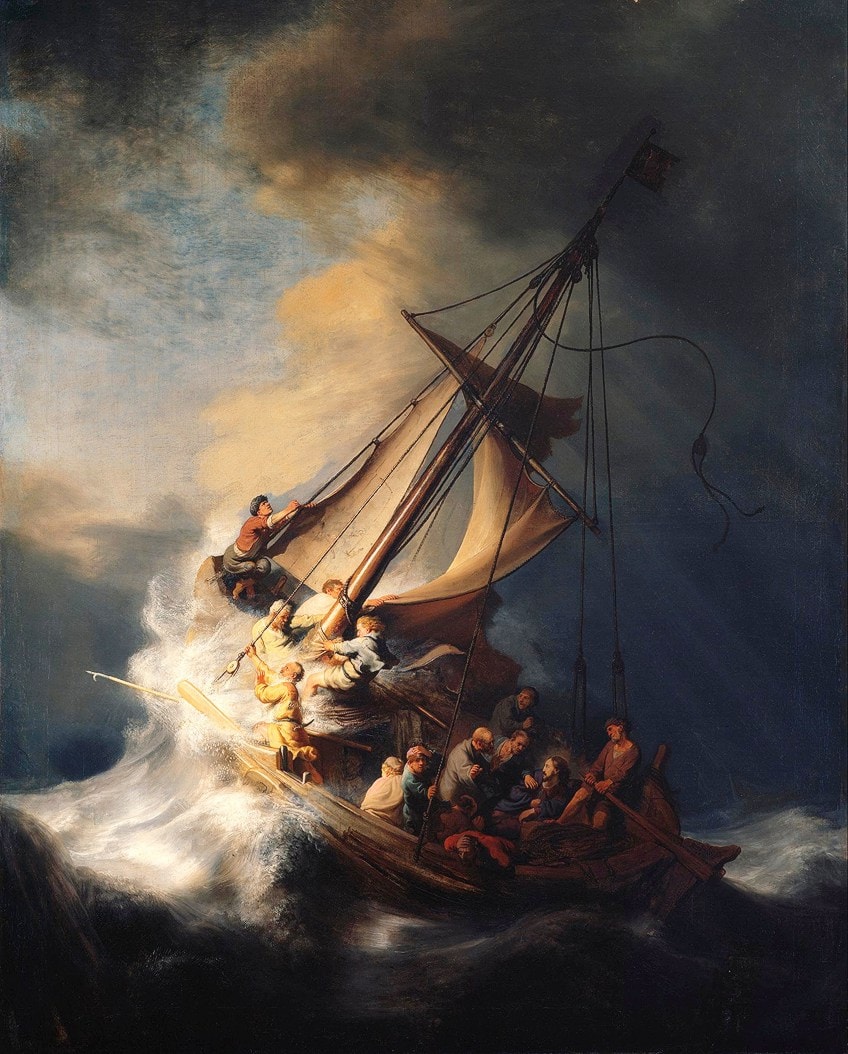
The Home Fleet Saluting the State Barge (1650) by Jan van de Cappelle
| Jan van de Cappelle (1624 – 1679) | |
| 1650 | |
| Oil on panel | |
| 64 x 92.5 | |
| Rijksmuseum, Amsterdam, Netherlands |
As numerous pilgrims and travelers journeyed to the New World across the Atlantic Ocean in the mid-1600s, seafaring transportation was responsible for shaping the world’s individuals and nations. In his 1650 marine artwork, Jan van de Cappelle caught one significant event from this time period. The picture portrays a variety of ships gathered in a port to honor a major vessel as it set off on its trip.
Cappelle’s artwork is considered among the most famous ship paintings because he captures the water’s capacity to reflect events above its surface in exquisite clarity.
Jan van de Cappelle was a painter of winter landscapes and paintings of ships at sea from the Dutch Golden Age , as well as an entrepreneur and art collector. He is widely regarded as the greatest marine artist of 17th-century Holland.
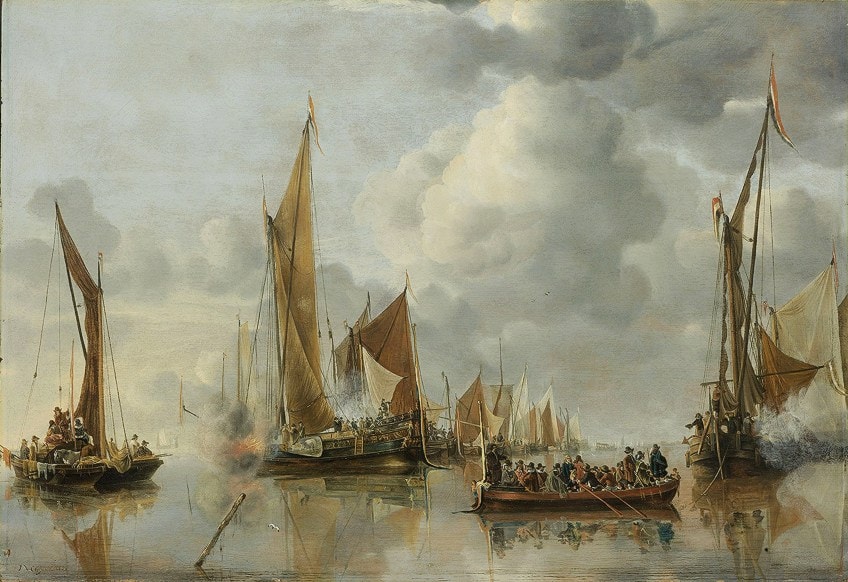
Nelson’s Inshore Blockading Squadron at Cadiz (1797) by Thomas Buttersworth
| Thomas Buttersworth (1768 – 1842) | |
| 1797 | |
| Oil painting | |
| 63.5 x 99 | |
| National Maritime Museum, London |
During the second part of the 18th century, the British Royal Navy was at the pinnacle of its nautical power throughout most of Europe and the rest of the world. During this period, the nation’s formidable navy fought in several conflicts off the coast of Portugal as the two countries competed for supremacy of the waterways around coastal Europe and other regions of the Atlantic. In 1797, Thomas Buttersworth produced this picture commemorating a decisive naval fight for British forces off the coastline of Portugal.
Following the historic Battle of St. Vincent, Nelson and ten bargemen were conducting a night attack against Spanish gunboats.
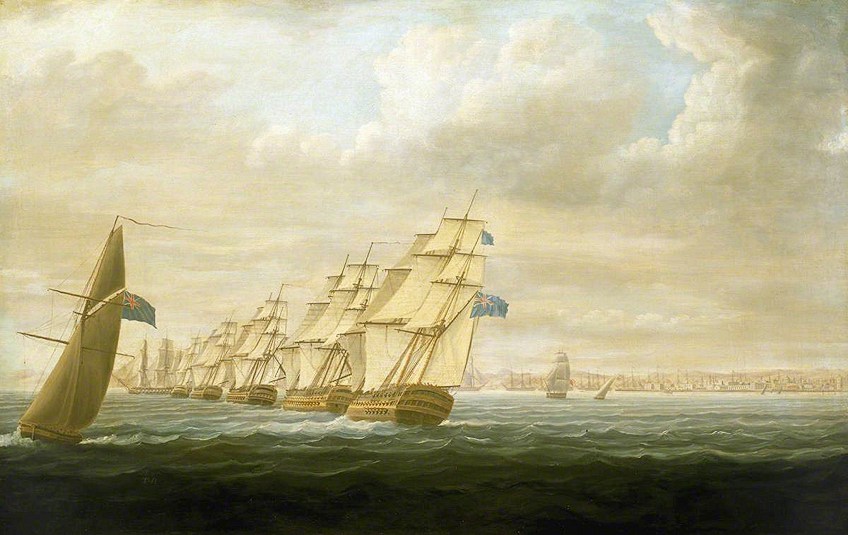
Battle of Trafalgar (1805) by Louis Philippe Crepin
| Louis Phillipe Crepin (1772 – 1851) | |
| 1805 | |
| Oil on canvas | |
| 90.93 x 80.78 | |
| National Maritime Museum, Greenwich, London |
A number of the most famous ship paintings depict bloody sea conflicts between formidable naval forces. This is true of Louis Phillipe Crepin’s 1805 work. This picture shows one of the most well-known naval battles, which occurred in the year the artwork was made. The fight faced the formidable British Royal Navy against two other worthy adversaries—the French and Spanish naval forces—who had collaborated to try to overthrow the overwhelming force that had controlled the waterways surrounding Europe and most of the world at the time.
Crepin’s picture depicts the close-quarters warfare that was common in naval conflicts with exceptional precision.
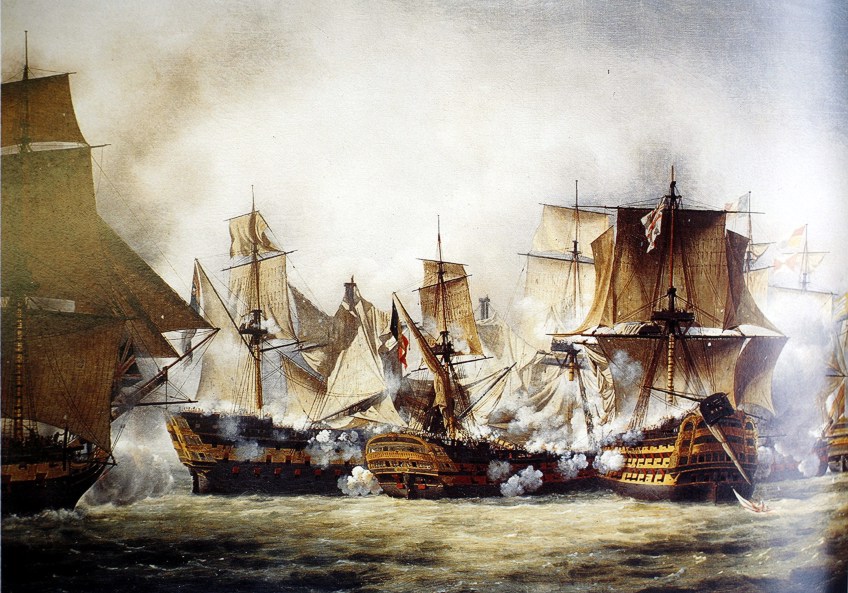
A First Rate Man-of-War Driven Onto a Reef of Rocks, Floundering in a Gale (1826) by George Philip Reinagle
| George Philip Reinagle (1802 – 1835) | |
| 1826 | |
| Oil on canvas | |
| 102 x 127.2 | |
| Royal Albert Memorial Museum, Exeter |
The early 1800s were most likely the peak of the legendary ship painting era. George Philip Reinagle was a well-known marine artist noted for his ability to portray the character of the sea’s often violent nature that has wrecked so many big, strong ships throughout history.
His 1826 masterpiece is adequately titled since it depicts a ship caught in the grasp of the surging sea.
One of the most exciting features of maritime travel was the risk that mariners may perish if caught in a raging storm, sometimes known as a gale. This work is famous for Reinagle’s ability to capture the massive, crushing power of the waves, as well as the sea spray whipped up by the fierce winds. This piece serves as a sobering reminder that not all marine exploration and adventure are safe.
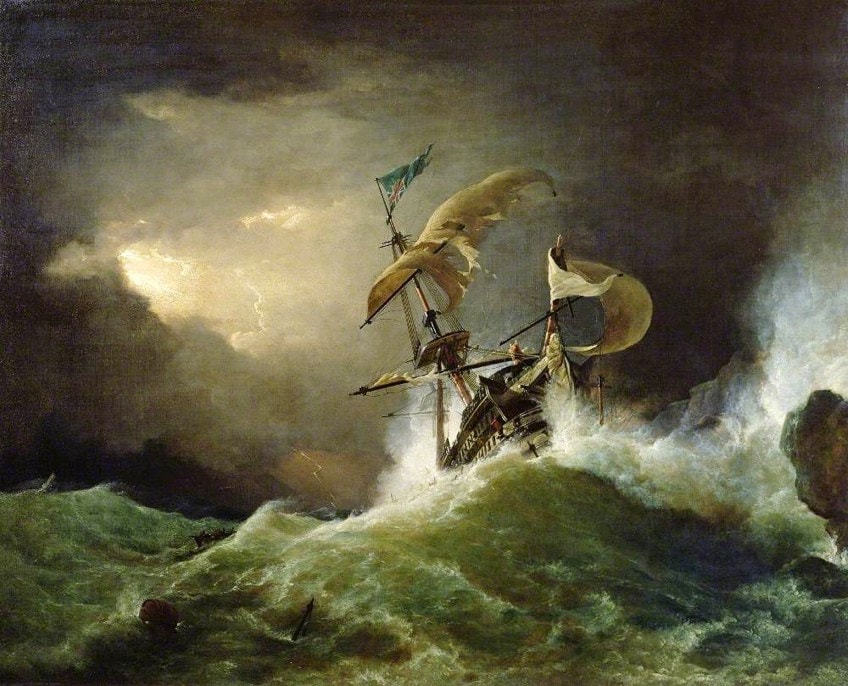
The Fighting Temeraire (1839) by J. M. W. Turner
| J. M. W. Turner (1775 – 1851) | |
| 1839 | |
| Oil paint | |
| 90.7 x 121.6 | |
| National Gallery, London |
The early industrial revolution is suggested by the marine artwork’s surroundings. Even though the sky is illuminated, a tugboat is rushing to assist. The tugboat stands for the new era of steam, coal, and fire. Turner’s own emotions and imagination are revealed in the image, which is intriguing and romantic. Although it is difficult to determine the painting’s message, it is unquestionably an important symbol of its time.
Turner’s boat painting features opposing hues that give it a magical or ethereal appearance. In contrast to the gloomy sky, the tugboat pops out.
A little portion of the painting’s bottom is taken up by the water, striking a balance between the sky and water. The Fighting Temeraire , while not well-liked in its day, has grown in popularity over time. A significant character in British art history, John Ruskin, spoke favorably of the piece. Although the artwork was eventually taken off the auction board, many reviewers, including Turner himself, praised it as a masterpiece. Nevertheless, Turner kept promoting his work despite the numerous unfavorable reviews.
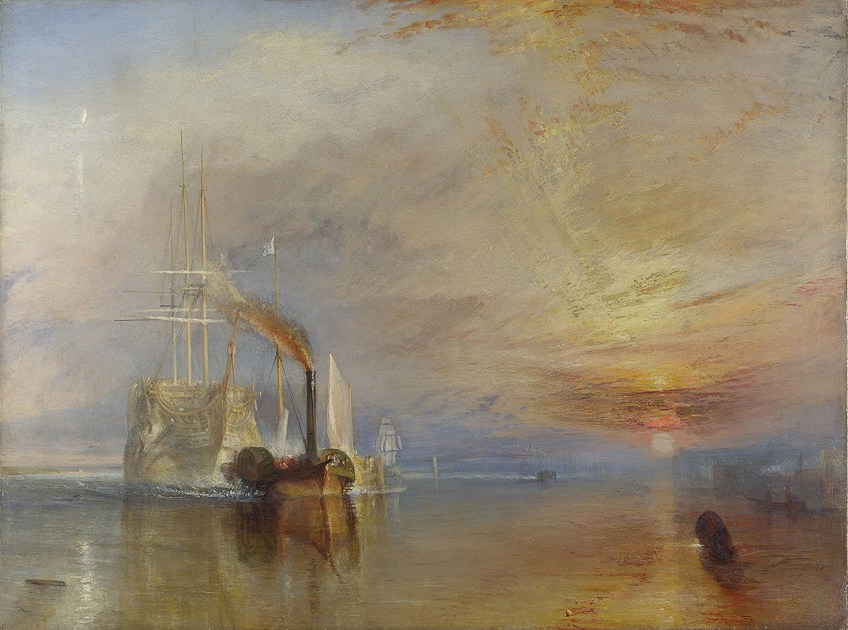
Becalmed off Halfway Rock (1860) by Fitz Hugh Lane
| Fitz Hugh Lane (1804 – 1865) | |
| 1860 | |
| Oil on canvas | |
| 70.4 x 120.5 | |
| National Gallery of Art, Washington, DC |
Several of the most famous ship paintings ever made depict warships engaged in furious conflicts or stuck in tremendous gales on the wide sea. There are, though, a few significant nautical paintings that reflect the placid, quiet character of the ocean or coastal regions. This piece portrays ships tied around Halfway Rock, a prominent maritime landmark located roughly halfway between Cape Ann and Boston.
This place was a popular stopping point for commercial vessels and supply ships since it allowed them to connect with other ships and conduct many forms of maritime commerce at a precise spot.
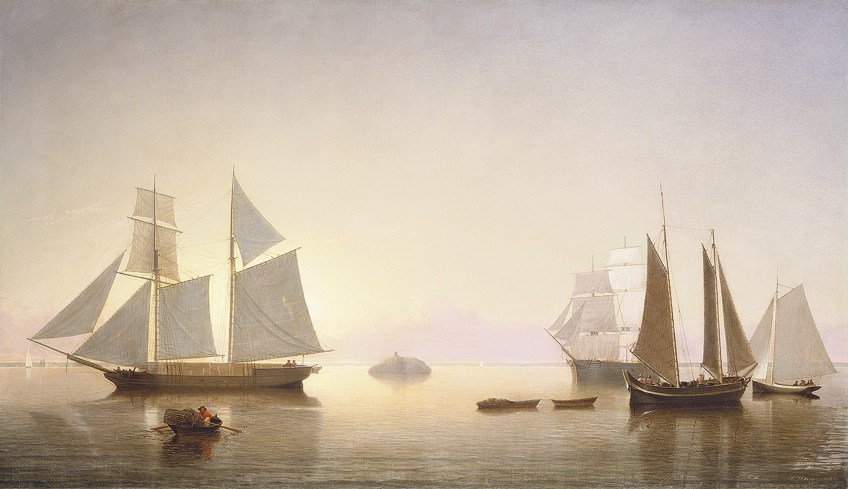
Red Boats, Argenteuil (1875) by Claude Monet
| Claude Monet (1840 – 1926) | |
| 1875 | |
| Oil painting | |
| 61.8 x 82.5 | |
| Musée d’Orsay, Paris, France |
Monet depicted the town and outlying areas of Argenteuil during the 1870s, creating images of harmony and beauty that were sometimes at odds with the realities of the time. Despite his belief in en Plein air painting , Monet painstakingly selected the components he wanted to incorporate and often completed his works in the studio.
His works include no hints of the contamination of the river at Argenteuil or the chaos of a community pushing all into its industry.
Monet created the composition in this painting by using boats, particularly the verticals of the masts. Again, he used contrasting colors in the form of oranges, blues, greens, and reds. The painting is vibrant with color, and the blues and purples depict the depth of the sea.
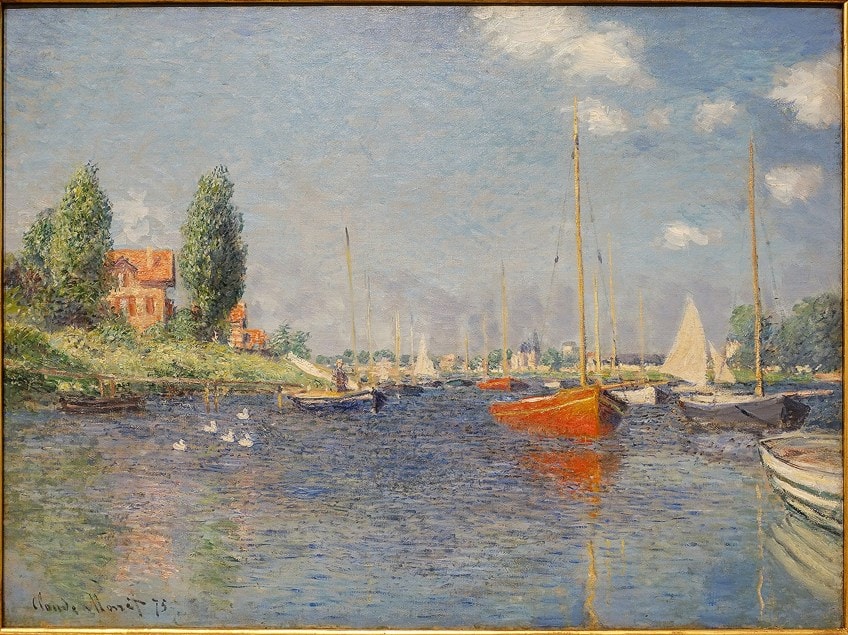
Breezing Up (A Fair Wind) (1876) by Winslow Homer
| Winslow Homer (1836 – 1910) | |
| 1876 | |
| Oil on canvas | |
| 61.5 x 97 | |
| National Gallery of Art, Washington, DC |
After visiting Massachusetts, where he first painted in watercolor, Homer started this painting in New York in 1873. He utilized the sketches he made there to create an oil painting that he worked on for three years. Infrared reflectography has shown the several composition modifications he made during this period, including the erasure of a fourth youngster near the mast and a second ship in the distance.
The artwork’s theme is upbeat; despite the turbulent seas, the boaters appear to be at ease. The anchor that substituted the person in the bow was said to represent hope.
The youngster at the helm looks to the horizon, an expression of hope for his and the nascent United States’ future. The final piece demonstrates that Homer was influenced by the substantial impact of Japanese art on Western artists in the 19th century, notably in the compositional balance between the dynamic and sparse parts. In 1866, Homer visited France, and the influence of French artists Claude Monet and Gustave Courbet’s nautical paintings is also visible.
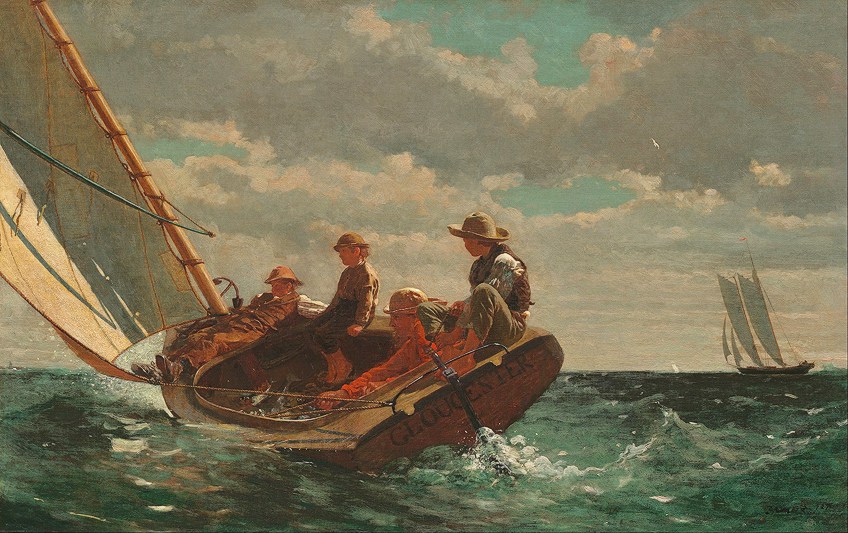
Fishing Boats on the Beach at Saintes-Maries (1888) by Vincent van Gogh
| Vincent van Gogh (1853 – 1890) | |
| 1888 | |
| Oil on canvas | |
| 39.5 x 53.3 | |
| Van Gogh Museum, Amsterdam |
This sailboat painting is a reworking of the artist’s drawing and is one of his most impressive attempts at establishing balance and harmony. The fishing boats stand in sharp contrast to his condition, serving as a source of optimism for the painter as he neared the end of his life. Vincent van Gogh applied his colors with a palette knife, and the contrasting blue and white portions of the water are filled with greens and blues to form the waves. He also produced the boats with a reed pen and added the white and blue colors with big scribbles.
As a result, the picture has a flowing movement and a blend of Impressionist and Realism elements.

Warship and sailboat paintings have always been popular subjects. This is likely due to the fact that ships have played such an important role in the development of civilization. Thanks to artists who are fascinated with these incredible vessels, we have many famous ship paintings to admire nowadays.
Take a look at our ship paintings webstory here!

Frequently Asked Questions
Why are paintings of ships at sea such a popular topic.
Ships have played an essential role in the past for humans, helping us explore new lands and peoples. Perhaps it is this sense of adventure and free spirit that artists personally resonate with. Or perhaps creating nautical paintings provides them with the chance to portray both nature and man-man creations.
What Do Famous Ship Paintings Portray?
Some artists depict intense battle scenes from human history. Others prefer to create sailboat paintings that have a more subdued and peaceful atmosphere. Other times, the artwork can have a biblical or mythological tale attached to it. Paintings of ships at sea are not only numerous but diverse in their themes and styles.

Isabella studied at the University of Cape Town in South Africa and graduated with a Bachelor of Arts majoring in English Literature & Language and Psychology. Throughout her undergraduate years, she took Art History as an additional subject and absolutely loved it. Building on from her art history knowledge that began in high school, art has always been a particular area of fascination for her. From learning about artworks previously unknown to her, or sharpening her existing understanding of specific works, the ability to continue learning within this interesting sphere excites her greatly.
Her focal points of interest in art history encompass profiling specific artists and art movements, as it is these areas where she is able to really dig deep into the rich narrative of the art world. Additionally, she particularly enjoys exploring the different artistic styles of the 20 th century, as well as the important impact that female artists have had on the development of art history.
Learn more about Isabella Meyer and the Art in Context Team .
Cite this Article
Isabella, Meyer, “Famous Ship Paintings – Best Nautical Paintings of Ships at Sea.” Art in Context. November 23, 2022. URL: https://artincontext.org/famous-ship-paintings/
Meyer, I. (2022, 23 November). Famous Ship Paintings – Best Nautical Paintings of Ships at Sea. Art in Context. https://artincontext.org/famous-ship-paintings/
Meyer, Isabella. “Famous Ship Paintings – Best Nautical Paintings of Ships at Sea.” Art in Context , November 23, 2022. https://artincontext.org/famous-ship-paintings/ .
Similar Posts
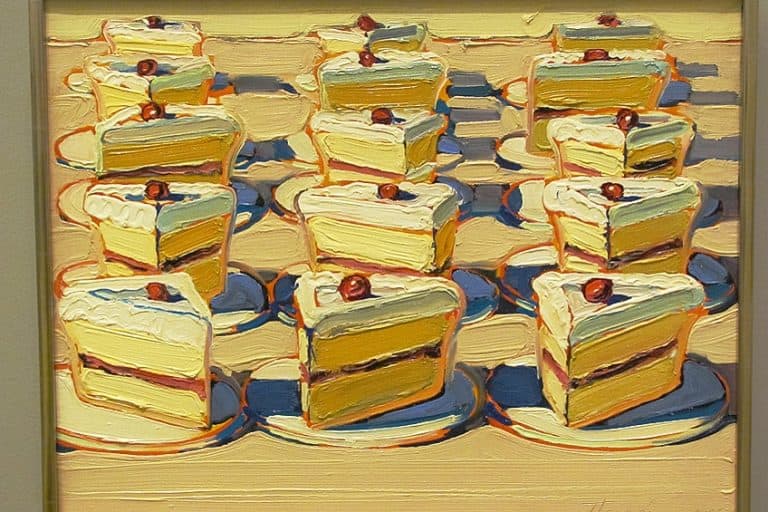
“Cakes” by Wayne Thiebaud – The Art of Dessert
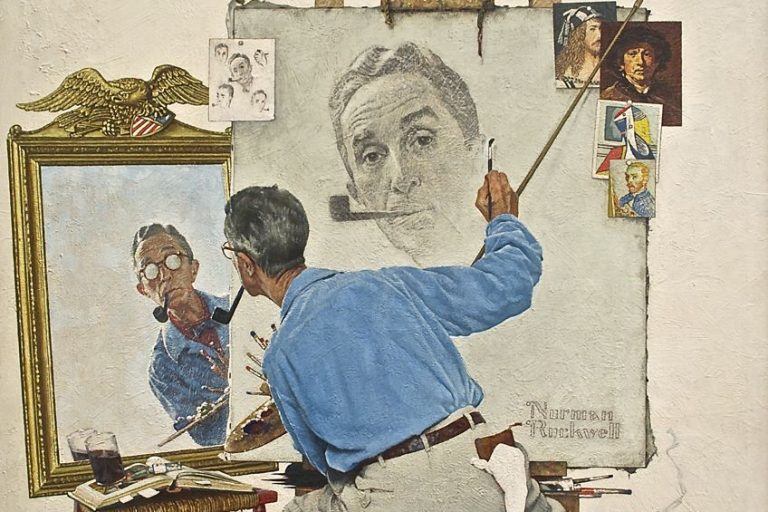
“Triple Self-Portrait” by Norman Rockwell – A Witty Introspection
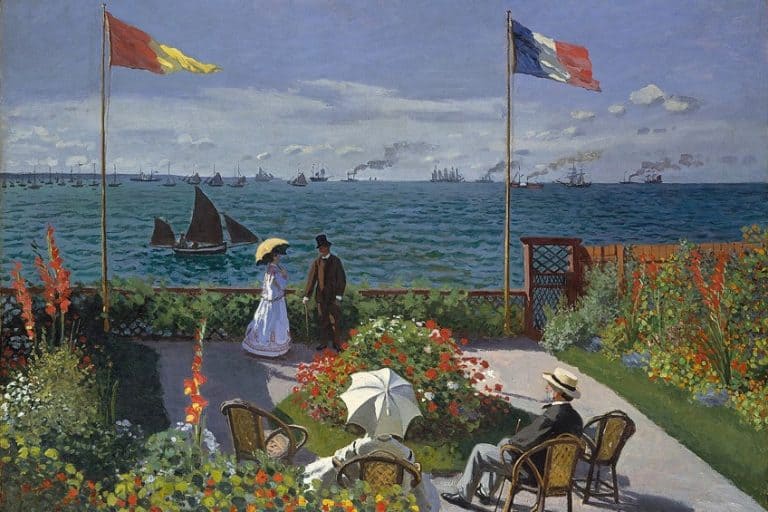
“Garden at Sainte-Adresse” by Claude Monet – The Masterpiece
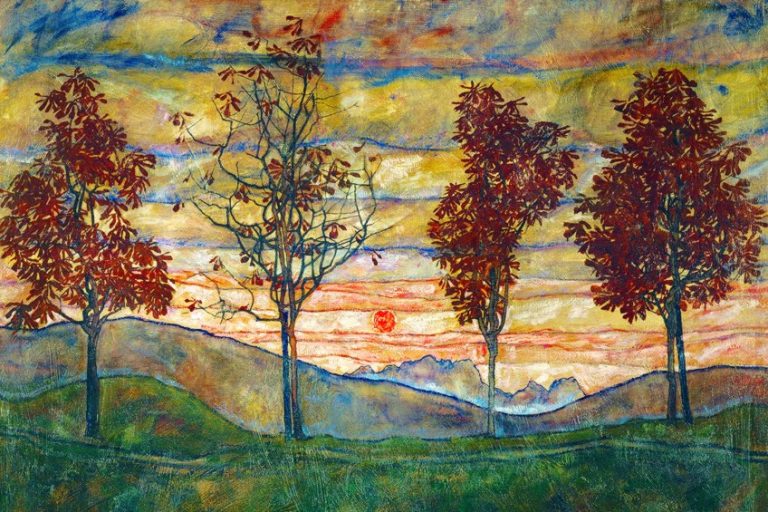
Famous Tree Paintings – The Most Famous Paintings With Trees
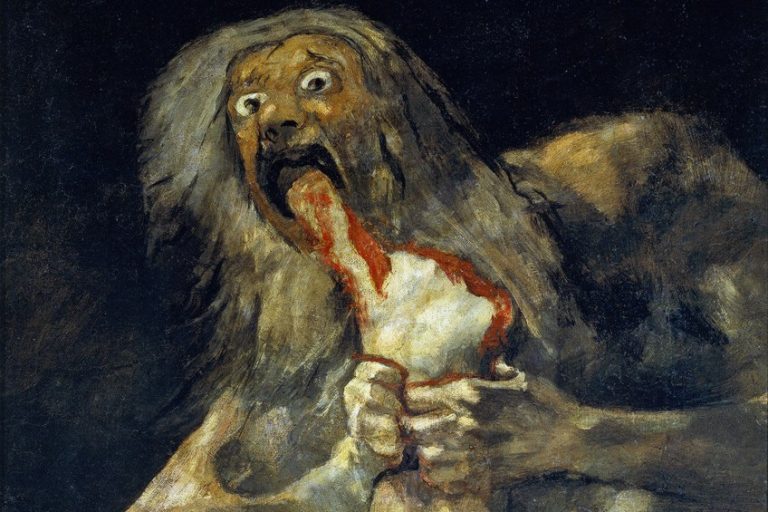
Francisco Goya “Black Paintings” – Examining Goya’s Dark Paintings
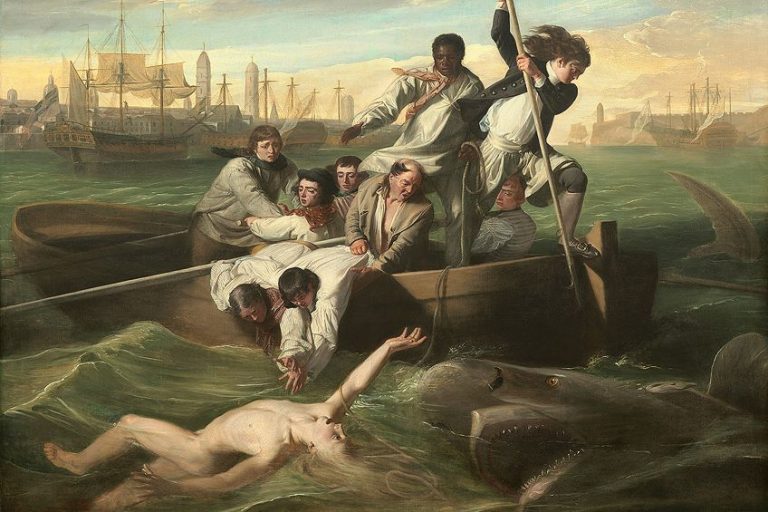
Watson and the Shark by John Singleton Copley – An Analysis
Leave a reply cancel reply.
Your email address will not be published. Required fields are marked *
Save my name, email, and website in this browser for the next time I comment.
The Most Famous Artists and Artworks
Discover the most famous artists, paintings, sculptors…in all of history!

MOST FAMOUS ARTISTS AND ARTWORKS
Discover the most famous artists, paintings, sculptors!


Claude Monet’s six most splendid paintings of sailboats
by Barista Uno | Nov 15, 2021 | Maritime Art, Culture and History

Sailboats held as much as fascination for French Impressionist master Claude Monet as water lilies and haystacks . He made several paintings of them. The following, in my opinion, are his most splendid works on the subject. They spotlight not only the beauty and elegance of sailboats. More importantly, they show Monet’s inimitable handling of colour, light and atmosphere.
“For me, a landscape does not exist in its own right, since its appearance changes at every moment; but the surrounding atmosphere brings it to life – the air and the light, which vary continuously. For me, it is only the surrounding atmosphere which gives subjects their true value.”
— claude monet, 1891 (as quoted by tate uk ).

Sailboat in Petit-Gennevilliers, 1874 Claude Monet (1840–1926) Courtesy of Wikimedia Commons
A sky exploding with wonderful colours and reflections on the serene waters of the Seine combine to transform an ordinary sailboat into something majestic.

Sailboats, regatta at Argenteuil, 1874 Claude Monet (1840–1926) Courtesy of Wikimedia Commons
Monet used the same pale palette for the sky, the sailboats and the river, adding tints of red for the houses to break the uniformity. Sky and water are dappled, and the boats are appear bunched together as they move gracefully along the river. All this gives the painting a peculiar kind of vitality and charm.

Le Havre, Fishing Boats Leaving the Port, 1874 Claude Monet (1840–1926) Courtesy of Wikimedia Commons
It’s a wet morning, but a crowd has gathered on the waterfront to watch the fishing boats sail out of the harbour to the open sea. The small figures in the foreground make the boats and their proud sails seem like multistoried buildings. This is captivating art with a narrative element.

Fishing Boats at Sea, 1868 Claude Monet (1840–1926) Courtesy of Wikiart: Visual Art Encyclopedia
Monet turned an ordinary day in the life of fishermen into a theatrical scene. The boat in the foreground is like an actor making his stage entrance as the curtain of day is raised. The two boats are rendered in dark brown to provide a contrast to the streaks of white light in the sky.

The Cliffs at Étretat, 1886 Claude Monet (1840–1926) Courtesy of Wikiart: Visual Art Encyclopedia
This painting — one of many done by Monet of the Étretat cliffs — is bursting with energy. Small patches of green, yellow and brownish orange are skillfully blended to create the impression of a dynamic but not choppy sea. The brightly coloured sky and the flotilla of small fishing boats accentuate the massive, towering cliffs.

Seascape, Storm, 1866 Claude Monet (1840–1926) Courtesy of The Clark, Massachusetts, USA
Seascape, Storm is an early work by Monet that is markedly different in style and technique from his later Impressionist paintings. In lieu of small, swift brushtrokes, the colours are applied solidly with some areas worked with a palette knife. The fishing boat is set against an ominous grey sky, and the sea is mostly a dark green. Just below the horizon line is a long strip of bright green, Monet suggesting perhaps that the storm will blow over, that there is hope.
You may also like
Art vs. reality: claude monet’s paintings of étretat.

Did you like this article? Buy me a coffee
Let us know what you think of this article.
If you like this site buy me a coffee

Recent Posts
- When the exploitation of Filipino cadets turns deadly
- 13 valuable tips for expats and foreign visitors in Manila
- Three reasons I keep writing about seafarers’ rights
- A cup of love from appreciative readers
- Stopping awhile for the children of Gaza
Don't Miss the Brew!
Sign up to be notified of updates to Marine Cafe Blog
You have Successfully Subscribed!
Pin it on pinterest.

IMAGES
COMMENTS
Choose your favorite sailboat paintings from 773 incredible artists. Featuring all kinds of sailboats, from sloops to schooners and yachts to yawls, this collection of paintings has something for everyone. These pieces of art invoke deep emotion with pictures of stormy weather, sleepy harbors and majestic, three-masted ships. With so many different styles and motifs to choose from, sailing ...
His 1876 painting titled Breezing Up (A Fair Wind) features a highly-detailed scene of a small sailboat cruising along on the waves as the sun is at the backs of the men and boys aboard the boat. In the painting, the boat’s sail is clearly filled with what many would consider to be a ‘fair wind’ as it leans heavily toward the water while ...
Nov 23, 2022 · Fishing Boats on the Beach at Saintes-Maries (1888) by Vincent van Gogh; Vincent van Gogh, Public domain, via Wikimedia Commons . Warship and sailboat paintings have always been popular subjects. This is likely due to the fact that ships have played such an important role in the development of civilization.
Dec 15, 2016 · Paintings of Sailboats. Author: Ali Wisch. Updated: Aug 2, 2017. Original: ... (CCA) is a collection of 1,400 ocean sailors with extensive offshore seamanship ...
Nov 15, 2021 · Sailboats, regatta at Argenteuil, 1874 Claude Monet (1840–1926) Courtesy of Wikimedia Commons. Monet used the same pale palette for the sky, the sailboats and the river, adding tints of red for the houses to break the uniformity. Sky and water are dappled, and the boats are appear bunched together as they move gracefully along the river.
Sailboat Painting Blue Ocean Oil Painting on Canvas Original Ship Art Seascape White Blue Painting Nautical Painting Sailing Boat Wall Art (212) Sale Price $496.50 $ 496.50